lock PONTIAC VIBE 2008 Owners Manual
[x] Cancel search | Manufacturer: PONTIAC, Model Year: 2008, Model line: VIBE, Model: PONTIAC VIBE 2008Pages: 368, PDF Size: 5.7 MB
Page 1 of 368
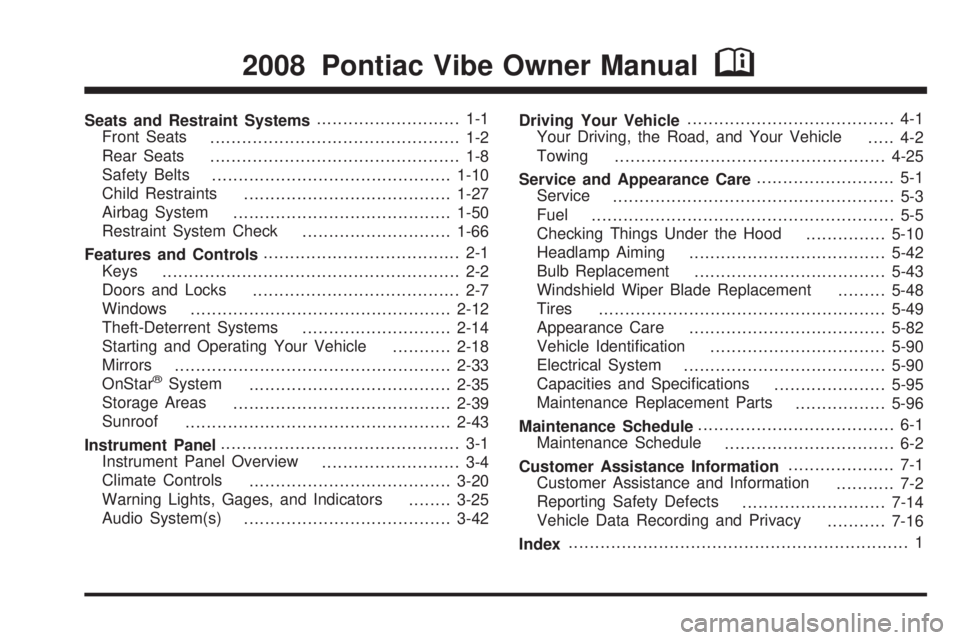
Seats and Restraint Systems........................... 1-1
Front Seats
............................................... 1-2
Rear Seats
............................................... 1-8
Safety Belts
.............................................1-10
Child Restraints
.......................................1-27
Airbag System
.........................................1-50
Restraint System Check
............................1-66
Features and Controls..................................... 2-1
Keys
........................................................ 2-2
Doors and Locks
....................................... 2-7
Windows
.................................................2-12
Theft-Deterrent Systems
............................2-14
Starting and Operating Your Vehicle
...........2-18
Mirrors
....................................................2-33
OnStar
®System
......................................2-35
Storage Areas
.........................................2-39
Sunroof
..................................................2-43
Instrument Panel............................................. 3-1
Instrument Panel Overview
.......................... 3-4
Climate Controls
......................................3-20
Warning Lights, Gages, and Indicators
........3-25
Audio System(s)
.......................................3-42Driving Your Vehicle....................................... 4-1
Your Driving, the Road, and Your Vehicle
..... 4-2
Towing
...................................................4-25
Service and Appearance Care.......................... 5-1
Service
..................................................... 5-3
Fuel
......................................................... 5-5
Checking Things Under the Hood
...............5-10
Headlamp Aiming
.....................................5-42
Bulb Replacement
....................................5-43
Windshield Wiper Blade Replacement
.........5-48
Tires
......................................................5-49
Appearance Care
.....................................5-82
Vehicle Identi�cation
.................................5-90
Electrical System
......................................5-90
Capacities and Speci�cations
.....................5-95
Maintenance Replacement Parts
.................5-96
Maintenance Schedule..................................... 6-1
Maintenance Schedule
................................ 6-2
Customer Assistance Information.................... 7-1
Customer Assistance and Information
........... 7-2
Reporting Safety Defects
...........................7-14
Vehicle Data Recording and Privacy
...........7-16
Index................................................................ 1
2008 Pontiac Vibe Owner ManualM
Page 6 of 368
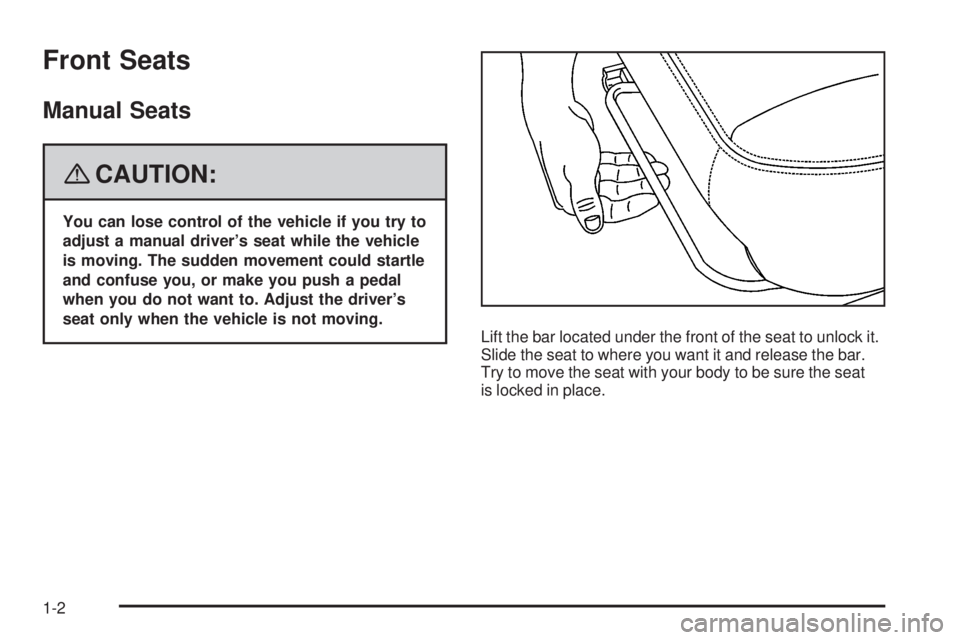
Front Seats
Manual Seats
{CAUTION:
You can lose control of the vehicle if you try to
adjust a manual driver’s seat while the vehicle
is moving. The sudden movement could startle
and confuse you, or make you push a pedal
when you do not want to. Adjust the driver’s
seat only when the vehicle is not moving.
Lift the bar located under the front of the seat to unlock it.
Slide the seat to where you want it and release the bar.
Try to move the seat with your body to be sure the seat
is locked in place.
1-2
Page 7 of 368
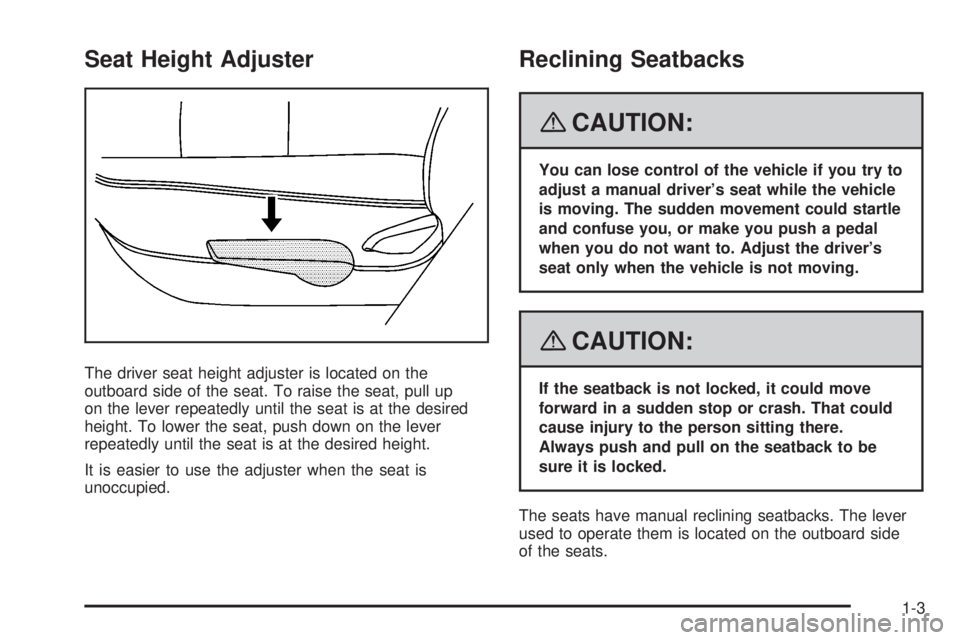
Seat Height Adjuster
The driver seat height adjuster is located on the
outboard side of the seat. To raise the seat, pull up
on the lever repeatedly until the seat is at the desired
height. To lower the seat, push down on the lever
repeatedly until the seat is at the desired height.
It is easier to use the adjuster when the seat is
unoccupied.
Reclining Seatbacks
{CAUTION:
You can lose control of the vehicle if you try to
adjust a manual driver’s seat while the vehicle
is moving. The sudden movement could startle
and confuse you, or make you push a pedal
when you do not want to. Adjust the driver’s
seat only when the vehicle is not moving.
{CAUTION:
If the seatback is not locked, it could move
forward in a sudden stop or crash. That could
cause injury to the person sitting there.
Always push and pull on the seatback to be
sure it is locked.
The seats have manual reclining seatbacks. The lever
used to operate them is located on the outboard side
of the seats.
1-3
Page 8 of 368
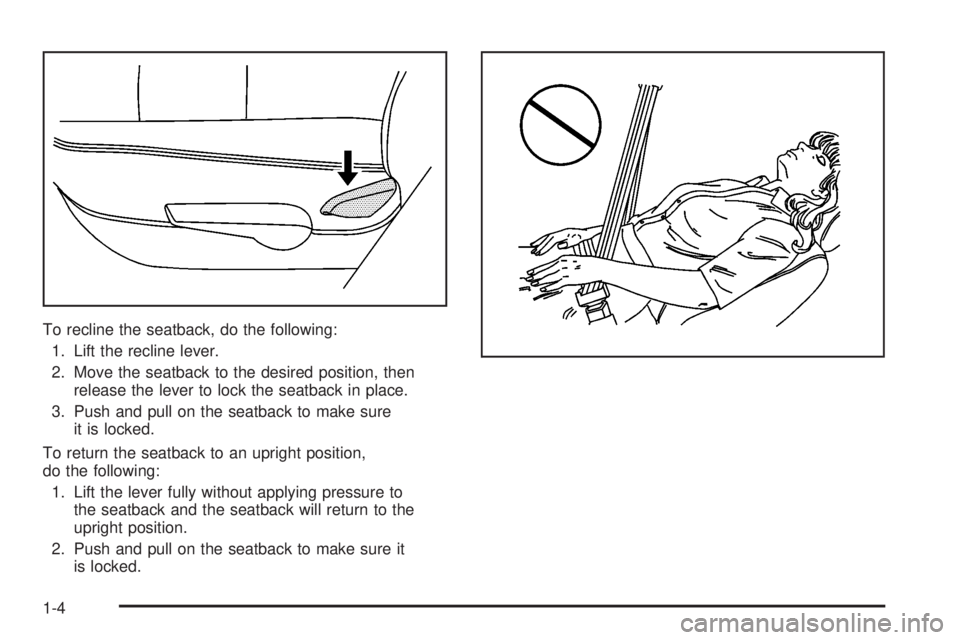
To recline the seatback, do the following:
1. Lift the recline lever.
2. Move the seatback to the desired position, then
release the lever to lock the seatback in place.
3. Push and pull on the seatback to make sure
it is locked.
To return the seatback to an upright position,
do the following:
1. Lift the lever fully without applying pressure to
the seatback and the seatback will return to the
upright position.
2. Push and pull on the seatback to make sure it
is locked.
1-4
Page 11 of 368
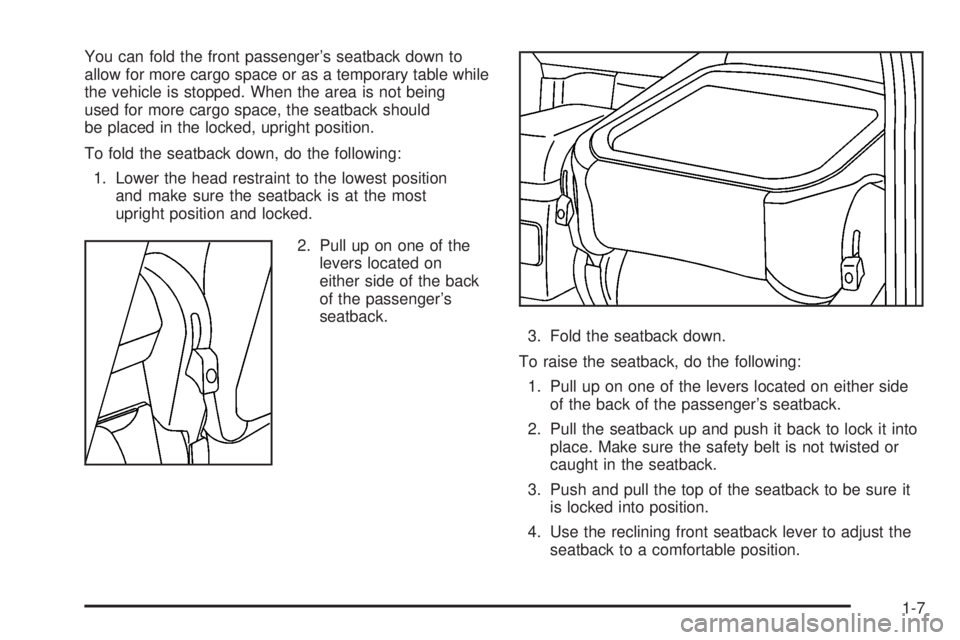
You can fold the front passenger’s seatback down to
allow for more cargo space or as a temporary table while
the vehicle is stopped. When the area is not being
used for more cargo space, the seatback should
be placed in the locked, upright position.
To fold the seatback down, do the following:
1. Lower the head restraint to the lowest position
and make sure the seatback is at the most
upright position and locked.
2. Pull up on one of the
levers located on
either side of the back
of the passenger’s
seatback.
3. Fold the seatback down.
To raise the seatback, do the following:
1. Pull up on one of the levers located on either side
of the back of the passenger’s seatback.
2. Pull the seatback up and push it back to lock it into
place. Make sure the safety belt is not twisted or
caught in the seatback.
3. Push and pull the top of the seatback to be sure it
is locked into position.
4. Use the reclining front seatback lever to adjust the
seatback to a comfortable position.
1-7
Page 12 of 368
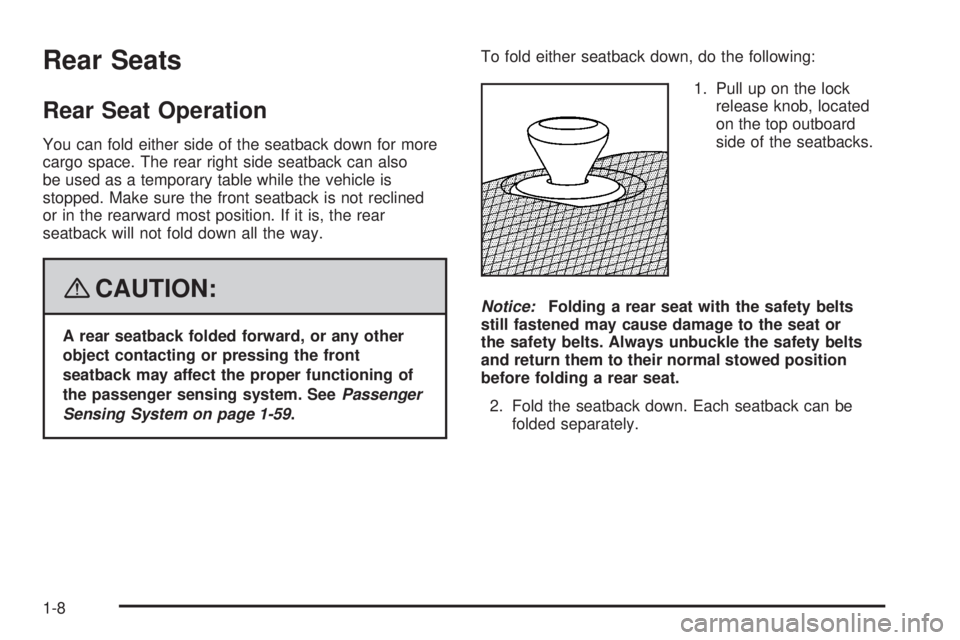
Rear Seats
Rear Seat Operation
You can fold either side of the seatback down for more
cargo space. The rear right side seatback can also
be used as a temporary table while the vehicle is
stopped. Make sure the front seatback is not reclined
or in the rearward most position. If it is, the rear
seatback will not fold down all the way.
{CAUTION:
A rear seatback folded forward, or any other
object contacting or pressing the front
seatback may affect the proper functioning of
the passenger sensing system. SeePassenger
Sensing System on page 1-59.To fold either seatback down, do the following:
1. Pull up on the lock
release knob, located
on the top outboard
side of the seatbacks.
Notice:Folding a rear seat with the safety belts
still fastened may cause damage to the seat or
the safety belts. Always unbuckle the safety belts
and return them to their normal stowed position
before folding a rear seat.
2. Fold the seatback down. Each seatback can be
folded separately.
1-8
Page 13 of 368
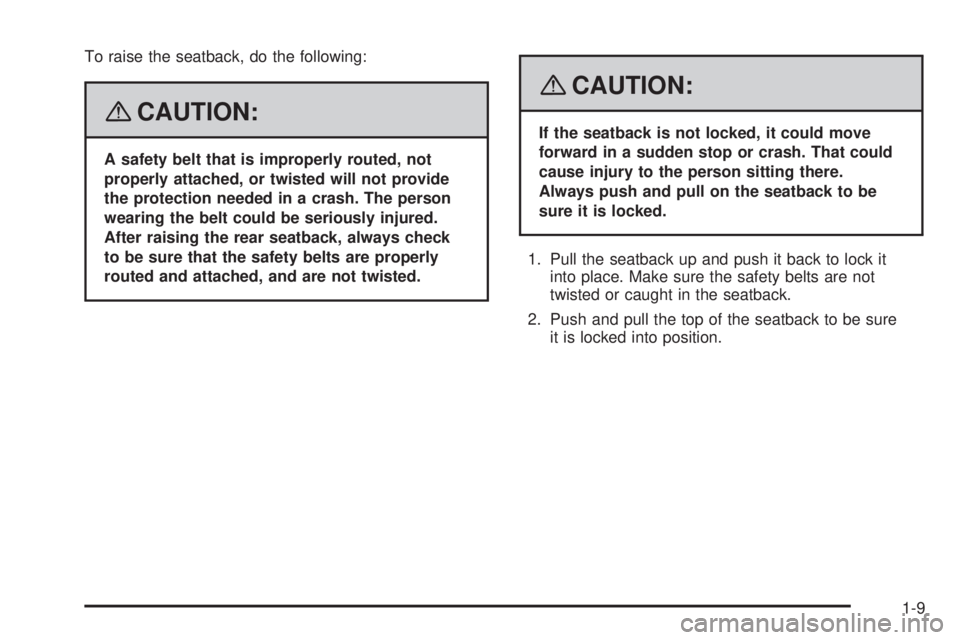
To raise the seatback, do the following:
{CAUTION:
A safety belt that is improperly routed, not
properly attached, or twisted will not provide
the protection needed in a crash. The person
wearing the belt could be seriously injured.
After raising the rear seatback, always check
to be sure that the safety belts are properly
routed and attached, and are not twisted.
{CAUTION:
If the seatback is not locked, it could move
forward in a sudden stop or crash. That could
cause injury to the person sitting there.
Always push and pull on the seatback to be
sure it is locked.
1. Pull the seatback up and push it back to lock it
into place. Make sure the safety belts are not
twisted or caught in the seatback.
2. Push and pull the top of the seatback to be sure
it is locked into position.
1-9
Page 19 of 368
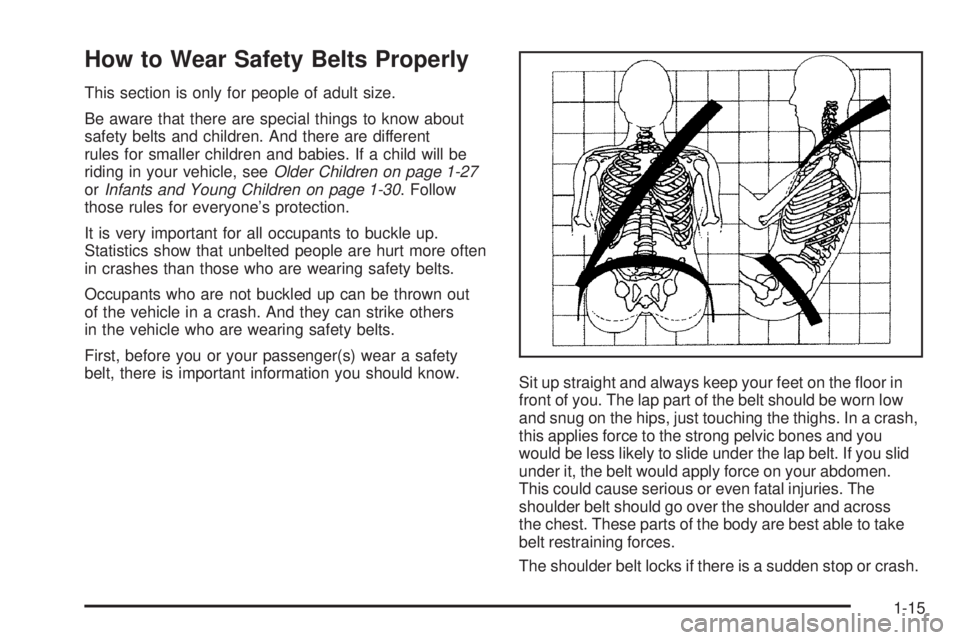
How to Wear Safety Belts Properly
This section is only for people of adult size.
Be aware that there are special things to know about
safety belts and children. And there are different
rules for smaller children and babies. If a child will be
riding in your vehicle, seeOlder Children on page 1-27
orInfants and Young Children on page 1-30. Follow
those rules for everyone’s protection.
It is very important for all occupants to buckle up.
Statistics show that unbelted people are hurt more often
in crashes than those who are wearing safety belts.
Occupants who are not buckled up can be thrown out
of the vehicle in a crash. And they can strike others
in the vehicle who are wearing safety belts.
First, before you or your passenger(s) wear a safety
belt, there is important information you should know.
Sit up straight and always keep your feet on the �oor in
front of you. The lap part of the belt should be worn low
and snug on the hips, just touching the thighs. In a crash,
this applies force to the strong pelvic bones and you
would be less likely to slide under the lap belt. If you slid
under it, the belt would apply force on your abdomen.
This could cause serious or even fatal injuries. The
shoulder belt should go over the shoulder and across
the chest. These parts of the body are best able to take
belt restraining forces.
The shoulder belt locks if there is a sudden stop or crash.
1-15
Page 27 of 368

Lap-Shoulder Belt
All seating positions in your vehicle have a
lap-shoulder belt.
Here is how to wear a lap-shoulder belt properly.
1. Adjust the seat, if the seat is adjustable, so you
can sit up straight. To see how, see “Seats” in
the Index.
2. Pick up the latch plate and pull the belt across you.
Do not let it get twisted.
The lap-shoulder belt may lock if you pull the belt
across you very quickly. If this happens, let the
belt go back slightly to unlock it. Then pull the
belt across you more slowly.
If you ever pull the shoulder portion of a passenger
belt out all the way, you may engage the child
restraint locking feature. If this happens, just let
the belt go back all the way and start again.3. Push the latch plate into the buckle until it clicks.
If you �nd that the latch plate will not go fully into
the buckle, see if you are using the correct buckle.
Pull up on the latch plate to make sure it is
secure. If the belt is not long enough, seeSafety
Belt Extender on page 1-26.
Make sure the release button on the buckle is
positioned so you would be able to unbuckle the
safety belt quickly if necessary.
1-23
Page 29 of 368

Shoulder Belt Height Adjuster
Your vehicle has a shoulder belt height adjuster for the
driver and right front passenger.
Adjust the height so that the shoulder portion of the belt
is centered on your shoulder. The belt should be away
from your face and neck, but not falling off your shoulder.
Improper shoulder belt height adjustment could reduce
the effectiveness of the safety belt in a crash.
To move it down, squeeze
the button (A) and move
the height adjuster to
the desired position.
You can move the
height adjuster up just
by pushing up on the
shoulder belt guide.
After you move the height adjuster to where you want
it, try to move it down without squeezing the release
button to make sure it has locked into position.
Safety Belt Pretensioners
Your vehicle has safety belt pretensioners for front
outboard occupants. Although you cannot see them,
they are part of the safety belt assembly. They can help
tighten the safety belts during the early stages of a
moderate to severe frontal or near frontal crash if the
threshold conditions for pretensioner activation are met.
If the passenger sensing system detects that there is
not a passenger in the right front passenger position,
the safety belt pretensioner for that position will not
activate. SeePassenger Sensing System on page 1-59.
Pretensioners work only once. If they activate in a
crash, you will need to get new ones, and probably other
new parts for your safety belt system. SeeReplacing
Restraint System Parts After a Crash on page 1-67.
1-25